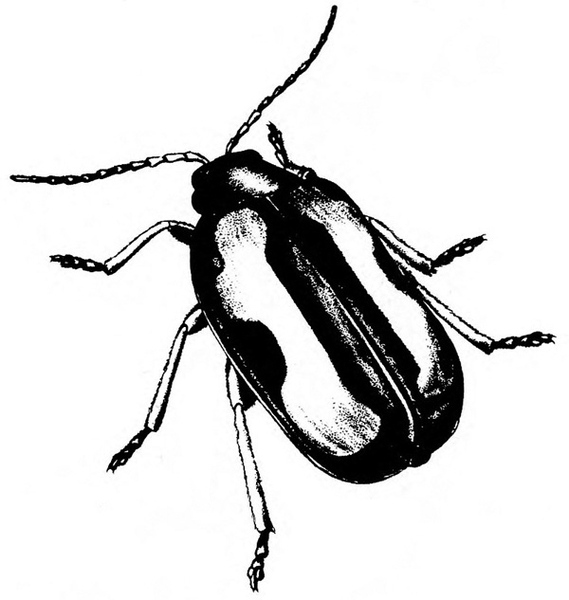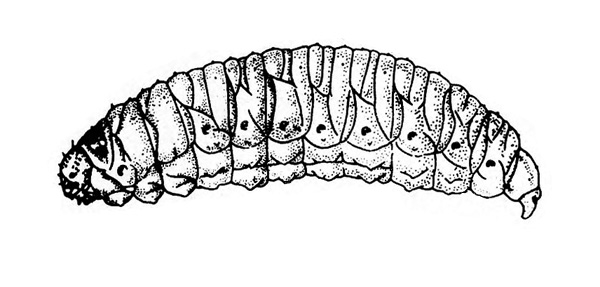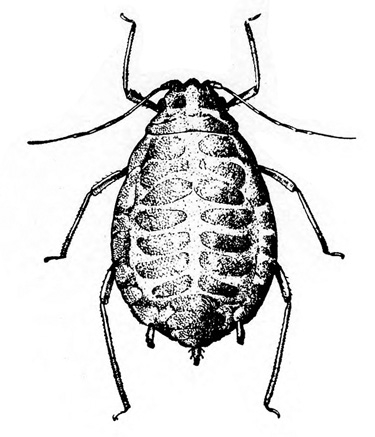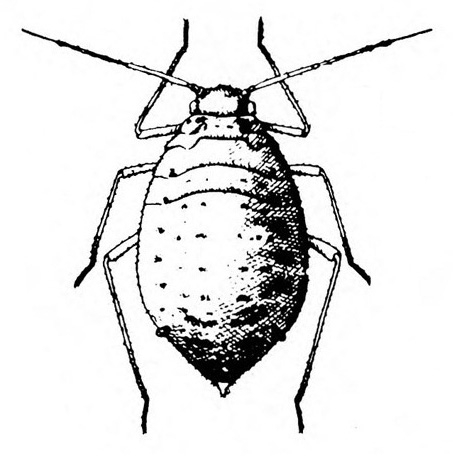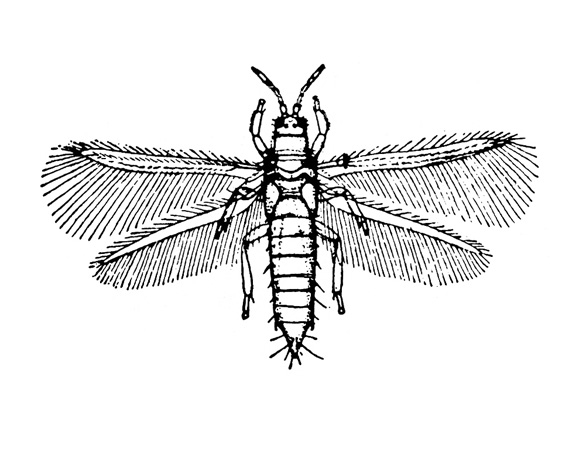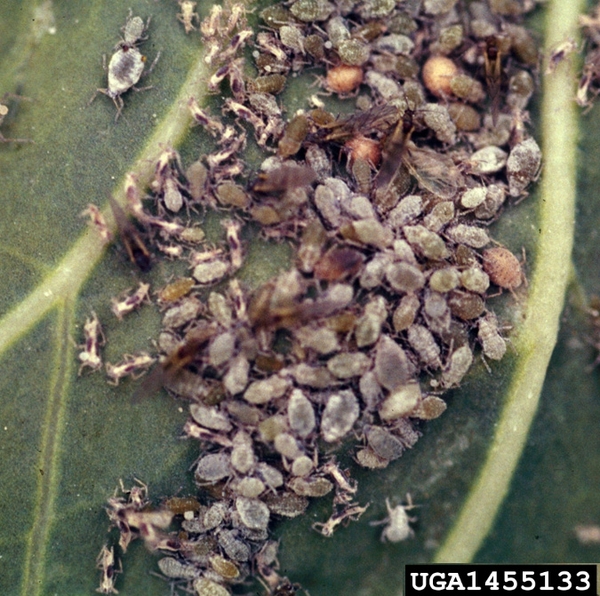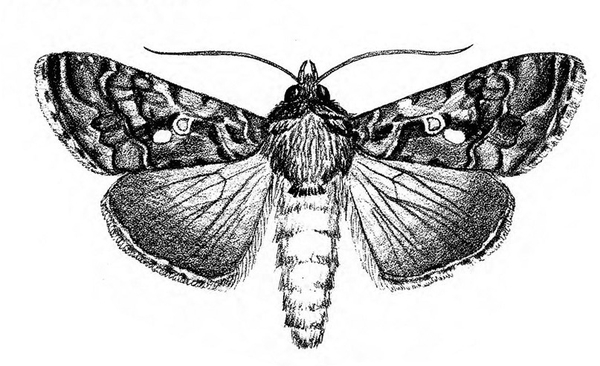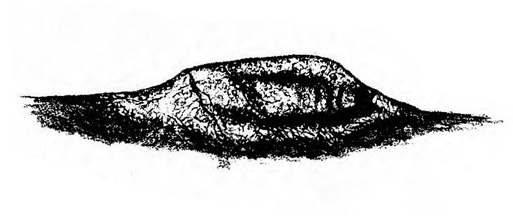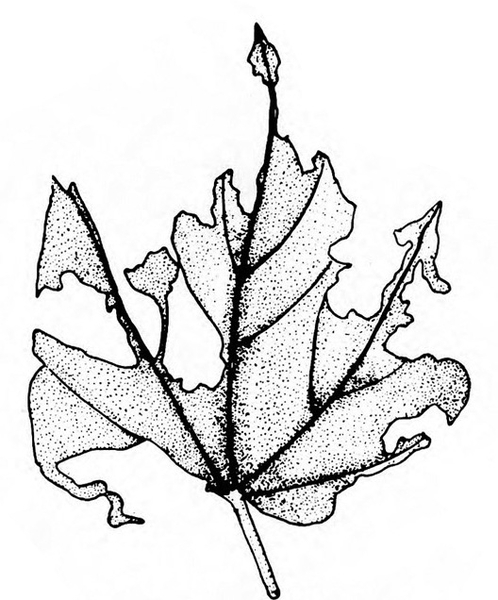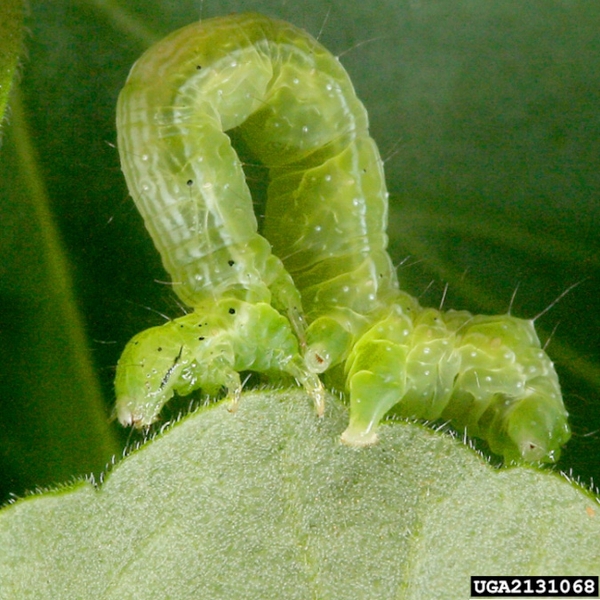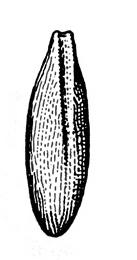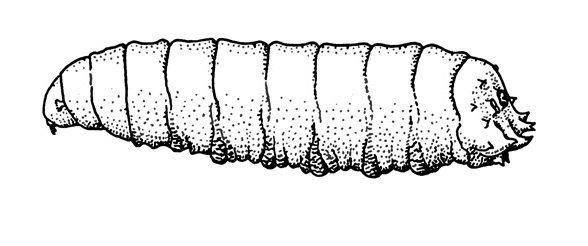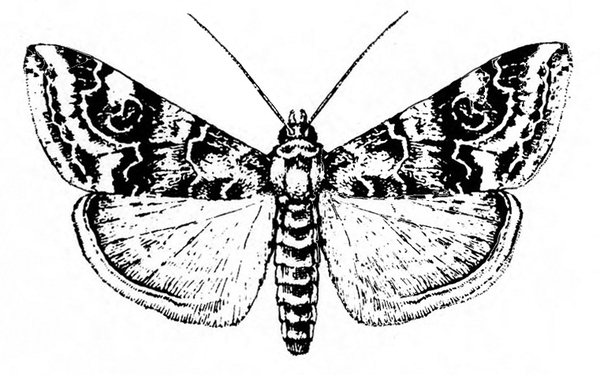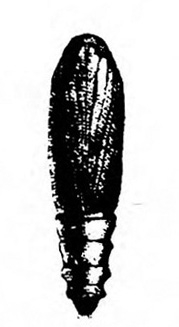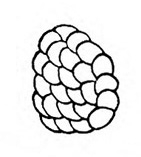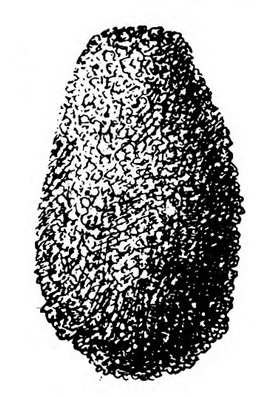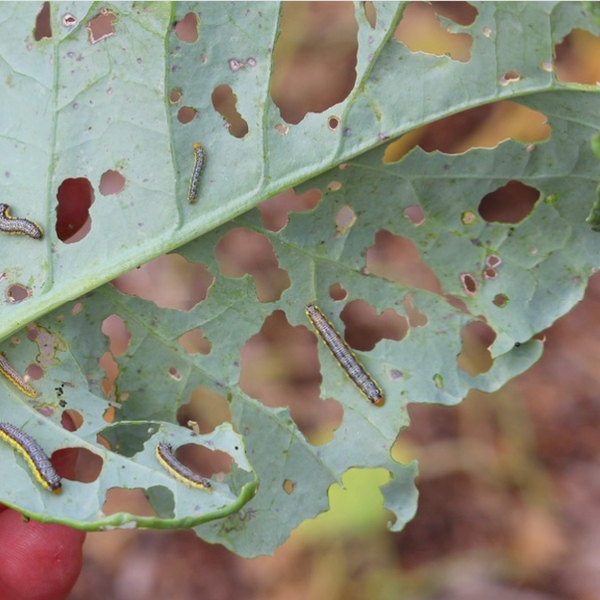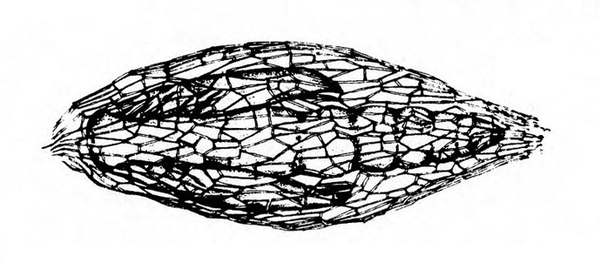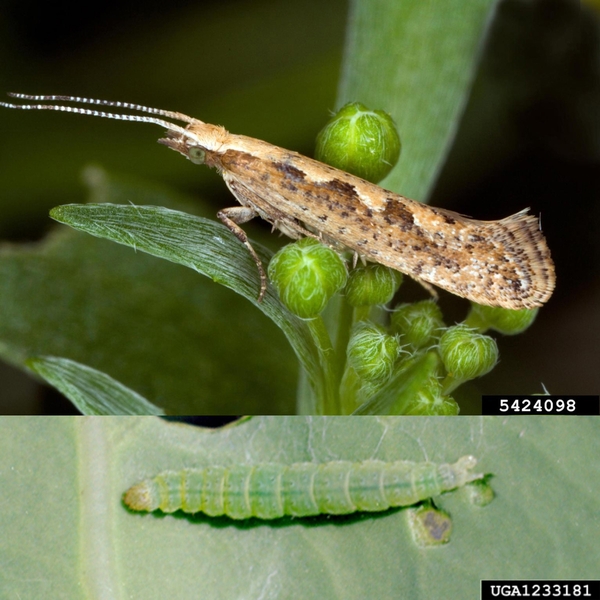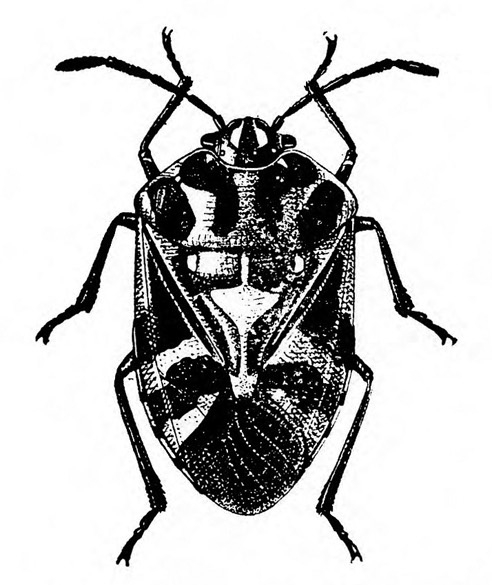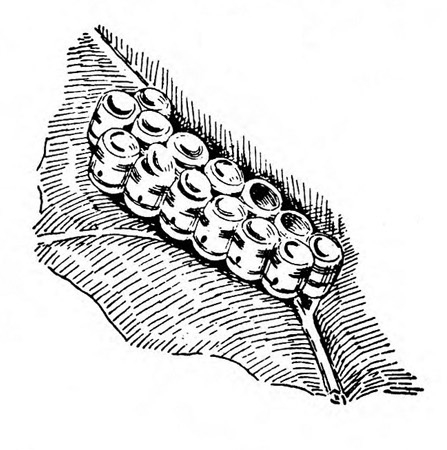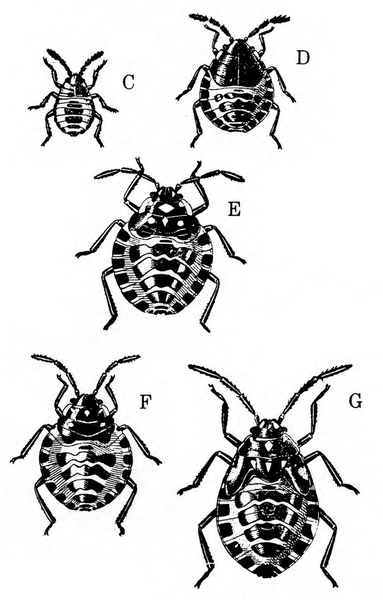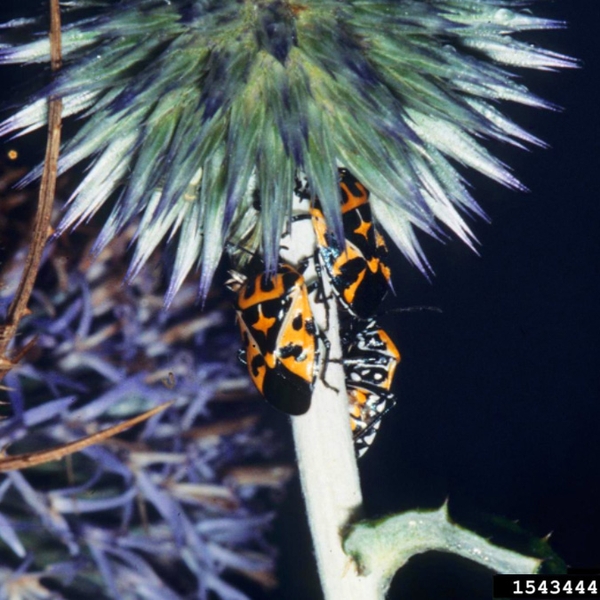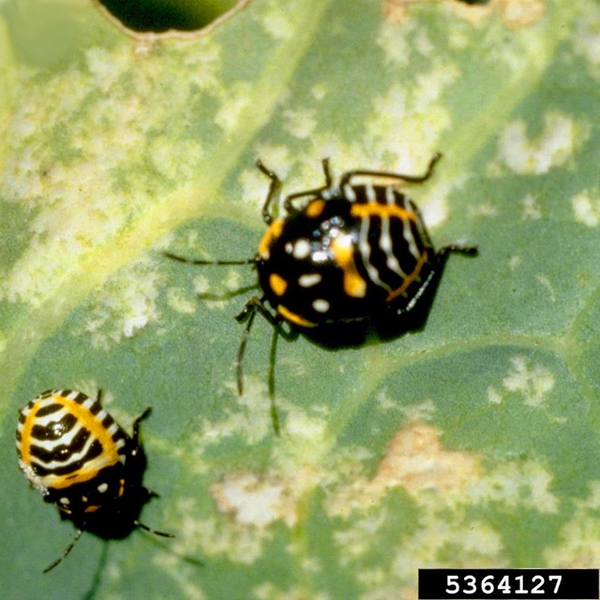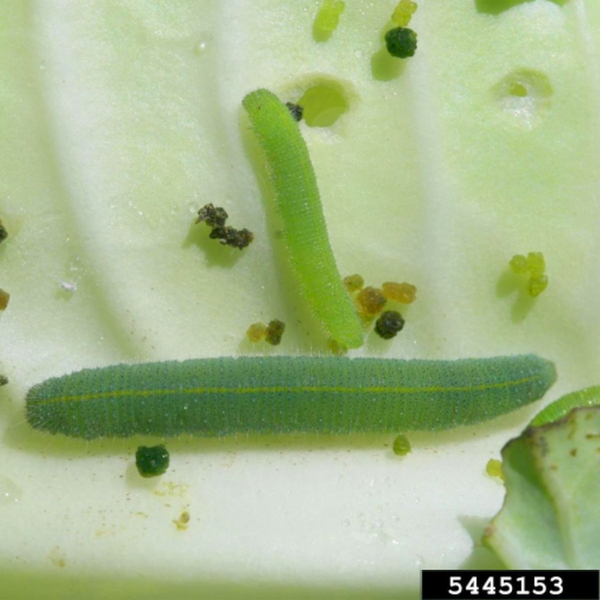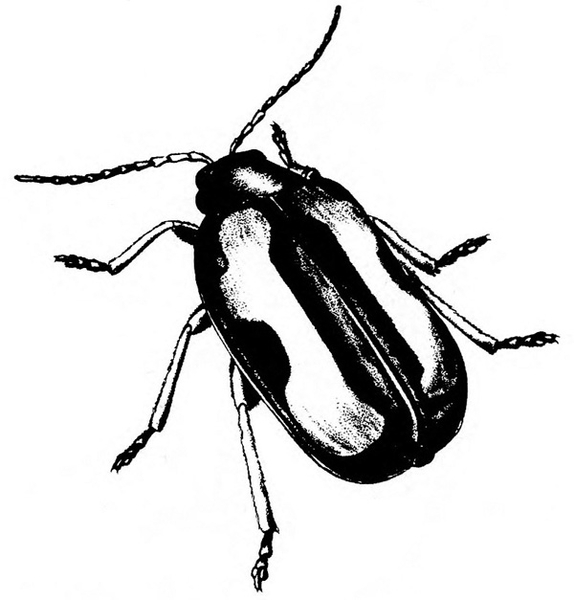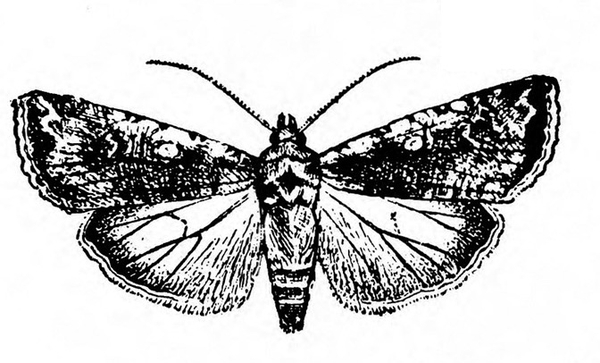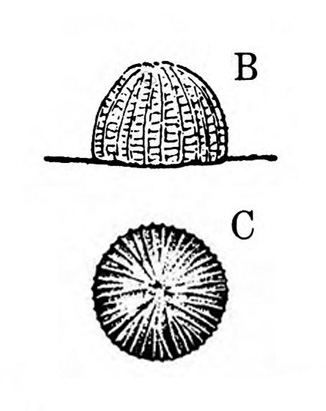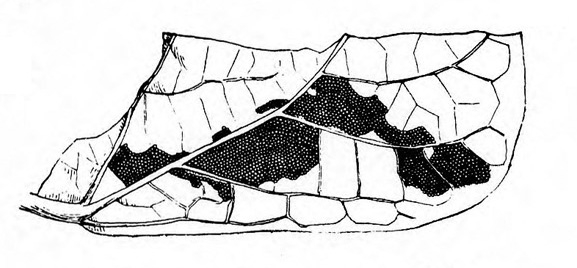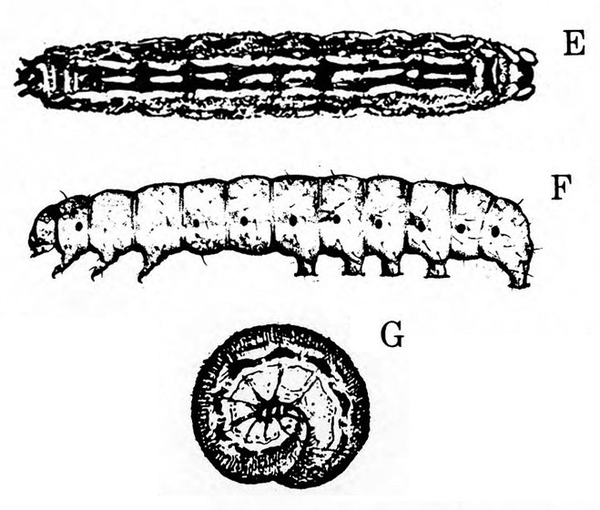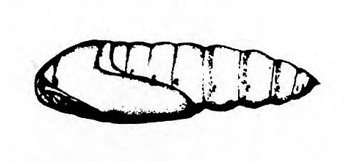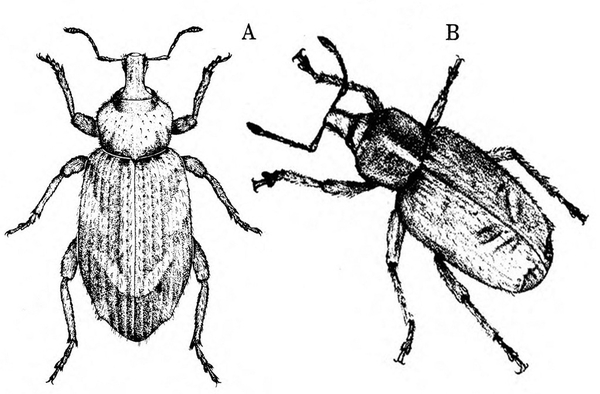Crucifers, which are plants of the mustard family, have a unique set of pests. With the exception of the cabbage looper, the vegetable weevil, and cutworms, pests of crucifers pose little or no threat to most other vegetable crops. A group of three caterpillars, known as the "cabbageworm complex," causes most damage to crucifiers. These include the cabbage looper, diamondback moth larva, and the imported cabbageworm. The cabbage maggot is the most important pest of crucifers in western North Carolina.
A. Chewing insects that leave holes in foliage or bore into stems and leaf veins
- Caterpillars with three pairs of legs and three to five pairs of prolegs
- Beet armyworm—A soft-bodied green or black caterpillar up to 1 3/16 inches long, the beet armyworm has three light-colored stripes running the length of the body, a black spot on each side of the body on the second segment behind the head, and five pairs of prolegs (Figure 1). It damages buds and young leaves. (For more information about beet armyworms, see "Pests of Asparagus.")
- Cabbage looper—A green caterpillar with longitudinal white stripes, the cabbage looper’s body is up to 1 3/16 inches long, tapering toward the head. It has three pairs of legs near the head and three pairs of fleshy prolegs (Figure 2). Young larvae are found on undersides of leaves; mature larvae are found deep within the head. The insects consume tender leaf tissue, leaving most veins intact.
- Cabbage webworm—A yellowish-gray caterpillar almost 5/8 inch long, it has a black head with a well-defined V-shaped mark. The mature larva bears five dark, longitudinal stripes and moderately long yellow or light-brown hairs. It has five pairs of prolegs (Figure 3). The larva bores into the plant, often destroying the bud or causing the plant to be deformed. It is sometimes found in a protective web along veins on the undersides of leaves. These pests are usually a problem only in fall.
- Corn earworm (also known as tomato fruitworm)—Early instars are cream colored or yellowish green with few markings; later-stage instars are green, reddish, or brown, with pale, longitudinal stripes and scattered black spots. They are up to 1 3/4 inches long and moderately hairy, with five pairs of prolegs (Figure 4). Corn earworms chew holes in leaves and sometimes bore into cabbage heads. (For more information about corn earworms, see "Pests of Sweet Corn.")
- Cross-striped cabbageworm—Early instars are gray with dark tubercles, a large head, and sparse body hairs. Mature larvae are bluish gray with black, transverse stripes and two stripes (one yellow, one black) down each side of the back. They may grow to almost 5/8 inch long and have five pairs of prolegs (Figure 5). They feed on buds and tender leaves.
- Diamondback moth larva—A pale-green caterpillar up to 3/8 inch long with a black head and scattered black hairs, it has five pairs of prolegs and is tapered slightly at both ends (Figure 7). The caterpillar wiggles rapidly when disturbed. It prefers to feed on the undersides of older leaves, between loose leaves, or on young buds. Bud damage prevents proper development of heads.
- Imported cabbageworm—A velvety-looking green caterpillar up to 1 1/4 inches long, it has a yellow stripe down the back, a row of yellow spots down each side, three pairs of legs near the head, and five pairs of prolegs (Figure 8). It feeds deeper in the plant and is more likely to eat small veins than the cabbage looper. Affected leaves are wet, with greenish-brown excrement deep among the leaves.
- Variegated cutworm—This fat, smooth-skinned caterpillar is pale gray or light brown and mottled with dark brown (Figure 6). The first three abdominal segments have two yellow or orange dots, and the eighth segment is marked with a dark W. Mature caterpillars grow up to 1 5/8 inches long and curl into a C-shaped ball when disturbed.
- Beetles or beetle larvae
- Striped flea beetle—A black, oval beetle a little more than 1/16 inch long, it has a wavy yellow line down each wing cover and enlarged hind legs for jumping (Figure 9). It makes small pits in leaves, and the remaining tissue drops out, leaving small "shot holes." It transmits some plant diseases.
- Vegetable weevil adult and larva—The dull, grayish-brown adult weevil is about 1/4 inch long, with a short, stout snout and a light V-shaped mark on the wing covers (Figure 10A). The larva is pale green, legless, and up to 9/16 inch long, with a dark, mottled head (Figure 10B). Adults and larvae feed primarily at night on buds and foliage.
B. Insects with needlelike or rasping mouthparts that cause foliage to be yellowed or distorted
- Cabbage and turnip aphids—Aphids are pale-green to dark, soft-bodied, pear-shaped insects with a pair of dark cornicles and a short “tail” (the cauda) protruding from the abdomen. The body is almost 3/8 inch long. They may be winged or wingless, though the wingless form is most common. Turnip aphids (Figure 11A) tend to be translucent pale-green to opaque dark-green, whereas cabbage aphids (Figure 11B) tend to be grayish green and covered with powdery wax. Aphids feed in colonies, cause discoloration or mottling of foliage, often transmit viruses, and excrete honeydew on which sooty mold grows.
- Harlequin bug—A black, shield-shaped bug up to 3/8 inch long, it has brightly colored orange, red, and yellow markings (Figure 12). It punctures stems and leaves, which develop irregular cloudy spots around each wound. Young plants wilt, turn brown, and die. Old plants are stunted.
- Onion thrips—This foliage-rasping pest has a pale-yellow to dark-brown body, 1/16 inch or shorter. The adult has two pairs of narrow, fringed wings (Figure 13). Thrips cause silvery blotches or scratch-like markings on leaves. Some infested leaves are distorted or curled upward. (For more information about onion thrips, see “Pests of Onion.”)
C. Insects that attack plants below ground
- Cabbage maggot—A white, legless maggot up to 1/4 inch long with a tapered head (Figure 14), it occurs in only a few mountain counties of North Carolina. It devours small roots and tunnels in stems and fleshy roots, making them brown and slimy. Aboveground, plants are stunted and of unusually pale color. Infested cabbage has sickly looking bluish-gray leaves.
- Variegated cutworm—This previously described insect usually eats foliage and also severs stems near the bases of plants.
- Vegetable weevil larva—This previously described insect feeds at night underground on large-rooted crucifers like turnips.
Cabbage and Turnip Aphids
Cabbage aphid, Brevicoryne brassicae (Linnaeus), Aphididae, HEMIPTERA
Turnip aphid, Lipaphis erysimi (Kaltenbach), Aphididae, HEMIPTERA
Description
Adult—Very similar in appearance, these two aphid species are various shades of green and are most commonly wingless (Figure 15A–C, Figure 15D–F). Both species have a pair of short, swollen cornicles (tailpipe-like appendages) on their abdomens. The cornicles of the cabbage aphid are shorter than the turnip aphid's. The cabbage aphid may be almost 1/8 inch long and is covered with a grayish, waxy coat. The turnip aphid has no such covering and is slightly smaller.
Egg—Virtually nonexistent in the South, the eggs of these aphids are minute, ovate, black, and laid only in the fall.
Nymph—The wingless nymphs resemble the adults in color and shape but are smaller (Figure 15D–F).
Biology
Distribution—Widely distributed throughout the United States, cabbage and turnip aphids are most troublesome in the southern states.
Host Plants—The cabbage aphid feeds primarily on broccoli, Brussels sprout, cabbage, cauliflower, collard, kale, and radish. Mustard is rarely infested. The turnip aphid typically infests mustard, radish, shepherd's-purse, turnip, and watercress. It also injures other crucifers, particularly in the seedling stage.
Damage—Aphids cluster on the undersides of leaves (Figure 16) and suck sap, causing infested foliage to curl, wilt, or become distorted. Some infested plants are quickly killed; others grow slowly, are stunted, and produce small, unmarketable heads.
Life History—In North Carolina, cabbage and turnip aphids continue to feed and produce offspring at reduced rates throughout the winter. Collard is an important overwintering host plant. As warm weather returns, aphid activity increases. Without mating, wingless female adults produce large numbers of live progeny (50 to 100) that develop into females. Periodically, females develop wings and fly to new host plants. Favored by moderate temperatures and dry weather, reproduction continues throughout summer. As many as 30 to 45 annual generations occur along the Gulf Coast; fewer are produced in North Carolina because development slows in colder winter temperatures.
Control
Cultural practices can help prevent aphid infestations. Plant the crop in a well-prepared, fertile seedbed to promote vigorous growth. Avoid planting near an aphid-infested crop or on land from which such a crop has been recently removed. Chemical control of aphid infestations is often necessary. For up-to-date recommendations, consult the North Carolina Agricultural Chemicals Manual.
Cabbage Looper
Trichoplusia ni (Hübner), Noctuidae, LEPIDOPTERA
Description
Adult—The cabbage looper moth has a wingspan of about 1 1/2 inches. Near the center of each brownish-gray forewing is a distinct small white circle with an adjacent irregular mark of the same color; the lighter-colored hind wings have dark margins (Figure 17A).
Egg—The round, greenish-white egg is slightly smaller than 1/32 inch in diameter.
Larva—The green larva has three pairs of prolegs and several white stripes that run the length of the body. When grown, the caterpillar is less noticeably striped and measures 1 3/16 inches long (Figure 17B). It moves in a characteristic "looping" manner (Figure 18).
Pupa—The green or brown pupa is about 3/4 inch long (Figure 17C) and encased in a loosely woven cocoon (Figure 17D).
Biology
Distribution—Native to North America, the cabbage looper is common from southern Canada into Mexico. In the United States, this caterpillar is primarily a problem in the South.
Host Plants—The cabbage looper infests a large range of plants. Some cultivated hosts include cabbage and related plants, cotton, potato, spinach, lettuce, celery, parsley, tomato, and soybean. Collard and cotton are preferred over broccoli, cauliflower, or cabbage for oviposition (egg-laying).
Damage—Injury from cabbage loopers closely resembles that of the imported cabbageworm. The young caterpillars feed on the undersides of leaves. As the larvae mature, they move to more protected areas deeper within cabbage heads. These larger larvae feed between leaf veins (Figure 17E) as they progress from the outer to the inner leaves.
Life History—Cabbage loopers overwinter as pupae. The inconspicuous night-flying moths emerge in spring, and females soon begin depositing 275 to 350 eggs, singly, on the upper surfaces of leaves. Several days later, young loopers hatch from the eggs and begin feeding. The caterpillars consume foliage voraciously for two to four weeks before spinning cocoons on the host plant foliage and pupating. Within two weeks, the next generation of moths emerges. Three or more generations occur each year in North Carolina.
Control
Planting resistant cabbage varieties such as Mammoth Red Rock, Chieftain Savoy, and Savoy Perfection Drumhead helps reduce cabbage looper damage. On most crucifers, however, chemical control of this pest becomes necessary. For up-to-date recommended chemicals and application rates, consult the North Carolina Agricultural Chemicals Manual.
Cabbage Maggot
Delia radicum (Weidemann), Anthomyiidae, DIPTERA
Description
Adult—The cabbage maggot adult (Figure 19A) resembles a common house fly, although it is somewhat smaller. It is gray, with three distinct black stripes on the thorax and a dark stripe along the top of the abdomen. It is 3/16 to 1/4 inch long. The eyes are reddish purple.
Egg—The white, finely ridged egg has a noticeable groove and is almost 1/16 inch long (Figure 19B).
Larva—The white, legless maggot (Figure 19C) has a tapered head and grows to 1/4 inch long.
Puparium—About the size of the adult, the pupa is enclosed in a hard brown puparium (Figure 19D).
Biology
Distribution—Introduced from Europe, the cabbage maggot is most injurious in Canada and the northern United States. It has been a problem in Illinois and western North Carolina but is rarely serious any farther south. In North Carolina, cabbage maggots have been reported from nearly all mountain counties west of a line from Polk County to Surry County and usually do not occur below 3,000 feet elevation.
Host Plants—The cabbage maggot feeds primarily on crucifers such as cabbage, cauliflower, broccoli, Brussels sprout, collard, kohlrabi, radish, and turnip. Beet, cress, and celery have also been infested.
Damage—Cabbage maggots eat small, fibrous roots and tunnel in stems and large, fleshy roots. Tunnels where maggots have fed become brown and slimy, and Phytophthora root rot or club root disease organisms are likely to be introduced at these points. Plants attacked in the plant bed or soon after setting in the field fail to develop normally. Affected cabbage first takes on a sickly gray-blue color. Other infested crucifers may appear stunted or pale in color. If severe damage has been done, plants may wilt and die during the heat of the day. Infestations are difficult to detect in radishes and turnips because the tunneling of maggots in these large-rooted crops does not cause the foliage to wilt. Damage to these crops can be determined only by pulling some plants early and inspecting them. Cabbage maggots are usually most severe when the weather is cool and wet for a long period.
Life History—Cabbage maggots overwinter as pupae 3/4 to 5 inches deep in the soil. As the soil warms in spring, adult flies emerge from puparia, feed on the nectar of flowers, and mate. Appearing as early as April, females soon begin depositing eggs in the soil at or near the bases of host plants. Three to seven days later, young maggots emerge from the eggs and move into the soil, searching for roots upon which they will feed for three to four weeks before pupating. Pupation may take place within root burrows or in nearby soil and usually lasts two or three weeks. The second generation of adults appears in late June or early July. At least three generations occur annually in North Carolina.
Control
Cultural practices such as late planting, careful selection of seedbed location, and elimination of weedy hosts can help prevent severe infestations. If planting is delayed until the last week of May or first week of June, fewer flies are present to deposit eggs. Seedbeds located as far as possible from growing areas and protected from egg-laying flies with a gauze cloth will be less likely to become infested. Using transplants grown in North Carolina at elevations below 3,000 feet will eliminate the danger of introducing the maggots on infested transplants. The fall destruction of turnip and cabbage stumps and weeds such as wild mustards will eliminate many larvae or pupae associated with these plants. Proper fertilization, irrigation, and good soil practices also lessen maggot damage by improving plant vigor.
Cabbage maggots often require chemical control. An insecticide can be broadcast and incorporated just prior to planting seed or setting transplants. Applying a drench after setting transplants may also be effective. For up-to-date recommendations for insecticides and rates of application, consult the North Carolina Agricultural Chemicals Manual.
Cabbage Webworm
Hellula rogatalis (Hulst), Pyralidae, LEPIDOPTERA
Description
Adult—This moth has brownish-yellow forewings mottled with darker brown and pale-gray hind wings (Figure 20A). The wingspan is slightly more than 1/2 inch. The moth rests on the ground, where it is well camouflaged, and takes short, erratic flights when disturbed.
Egg—Oval and about 1/16 inch long, the egg is grayish white at first, later acquiring a pinkish hue.
Larva—The first-instar larva has a pale, yellowish-gray body almost 1/16 inch long and a dark, wide head. The mature larva (Figure 20B) is also yellowish gray but has five dark, longitudinal stripes with moderately long yellow and light-brown hairs. It is 1/2 to almost 5/8 inch long. The black head has a well-defined V-shaped mark.
Pupa—The yellowish-brown pupa (Figure 20C) is 1/4 inch long and a little more than 1/16 inch wide. It is enclosed within a cocoon about 3/8 inch long made of silk and soil particles.
Biology
Distribution—Primarily a problem in southern states, the cabbage webworm occurs from North Carolina south to Florida and westward into California.
Host Plants—Cabbage webworms attack most crucifers and some closely related weedy plants. Hosts include cabbage, turnip, beet, collard, cauliflower, kale, rutabaga, radish, kohlrabi, mustard, rape, horseradish, shepherd's-purse, and purslane.
Damage—In North Carolina, cabbage webworms do not damage spring cole crops. In late summer or early fall, however, young plants of the fall crop are susceptible to attack. By boring into buds, stems, and stalks, webworms destroy or disfigure buds and sometimes kill plants. Plants with destroyed buds will produce secondary buds, but these are not likely to mature into marketable heads by harvesttime. Webworms feeding on the outer leaves of older plants are harmless. Webworms are enclosed by protective silken webs and often hide along leaf veins on the undersides of leaves. They feed during the day, but are fairly inactive during cold weather.
Life History—Little information is available on the life history of the cabbage webworm in the southern United States. Closely related species overwinter as larvae or pupae in silk-lined cells in the soil. Cabbage webworm moths deposit about 300 to 350 eggs on the buds of host plants. About three days later, larvae emerge and feed in the buds, eventually moving to the outer leaves, where they spin webs and continue to feed along large leaf veins. They pupate among shed leaves or other refuse on the ground. The number of annual generations in North Carolina has not been determined.
Control
Cabbage webworm control is not necessary on spring-planted crucifers. On fall-planted crucifers, control is primarily preventive. Plants should be sprayed or dusted as soon as they come up or are set out. For up-to-date recommended insecticides and rates, consult the North Carolina Agricultural Chemicals Manual.
Cross-Striped Cabbageworm
Evergestis rimosalis (Guenée), Pyralidae, LEPIDOPTERA
Description
Adult—This yellowish-brown moth (Figure 21A) has a body about 3/8 inch long and a wingspan of about 1 inch. The mottled forewings are marked with dark-brown zigzag lines. The pale hind wings have five or six small, dusky spots between the middle of the wing and its inner border.
Egg—The egg mass, laid on the foliage, consists of thin, oval, flattened eggs that overlap like fish scales (Figure 21B). Each individual yellow egg is almost 1/16 inch wide.
Larva—Very small when newly hatched, the first-instar larva has a large head and uniformly gray body sparsely covered with hairs. A mature larva has a bluish-gray body up to 3/4 inch long with tiny, black, transverse stripes (Figure 21C). A black stripe with a yellow stripe underneath runs along each side of the body. The underside of the larva is green and mottled with yellow.
Pupa—The yellowish-brown to dark-brown pupa is 7/16 to 1/2 inch long and enclosed in a light-gray cocoon with particles of enmeshed sand. The cocoon (Figure 21D) is about 5/8 inch long and 3/8 inch wide.
Biology
Distribution—Cross-striped cabbageworms have been reported in many states, from Delaware and Nebraska southward. Moths have been collected farther north, but this insect is believed to be primarily southern in distribution.
Host Plants—Cabbage, turnip, and related plants are the only known hosts of this pest.
Damage—Because eggs are deposited in masses, individual plants may be infested with large numbers of cross-striped cabbageworms. The caterpillars feed on all tender plant parts but prefer terminal buds. Young leaves and buds are often riddled with holes (Figure 22).
Life History—No biological studies of this pest have been conducted in North Carolina, but in Washington, D.C., the cross-striped cabbageworm is reported to produce four generations per year. They probably overwinter as larvae and pupate in spring. Pupation occurs just below the soil surface and lasts about six days. Moths emerge from pupae and soon deposit eggs in masses of 20 to 30 on the undersides of leaves. Under warm, favorable conditions, eggs hatch in about six days. Larvae develop in about two to three weeks in summer, but they require longer to develop during cooler weather.
Control
For up-to-date recommended insecticides and rates, consult the North Carolina Agricultural Chemicals Manual.
Diamondback Moth
Plutella xylostella (Linnaeus), Yponomeutidae, LEPIDOPTERA
Description
Adult—This grayish-brown moth has narrow forewings, conspicuously fringed hind wings, and a 3/4-inch wingspan (Figure 23A). When the male is at rest, the wings come together to form a line of white or pale-yellow diamonds down the middle of the back (Figure 24).
Egg—The minute, round egg is pale yellow.
Larva—Tapering slightly at both ends, this pale-green larva has a black head and scattered black hairs and reaches a length of 5/16 inch when mature (Figure 23B and Figure 24). It wriggles rapidly when disturbed, often dropping from the plant and hanging by a silklike thread.
Pupa—The yellowish pupa is enclosed within a loosely spun, gauzelike cocoon (Figure 23C) measuring about 1/4 inch long.
Biology
Distribution—Native to Europe, the diamondback moth can be found throughout the United States and in all areas of the world where cole crops are grown. It also can be a problem in greenhouses.
Host Plants—The diamondback moth is a pest of almost all crucifers, including cabbage, broccoli, cauliflower, collard, kale, Brussels sprout, kohlrabi, turnip, radish, mustard, and watercress.
Damage—Diamondback moth larvae feed on all plant parts but prefer the undersides of older leaves, crevices between loose leaves, and young buds. They eat small holes in leaves and buds or feed superficially, leaving slight indentations instead of holes. When populations remain low, these small caterpillars cause little damage; in large numbers, however, they are particularly injurious to young plants. Heavy feeding on buds may cause the marketable portion of the plant to fail to develop properly.
Life History—Diamondback moths overwinter as adults among field debris of crucifer crops. In spring, females lay eggs, singly or in groups of two or three, on foliage. Larvae hatch from eggs a few days later and feed for about 10 days during warm weather and a month during cool seasons. Larvae first feed by leaf-mining but soon emerge and infest the undersides of leaves. Once mature, larvae spin loose cocoons that remain attached to lower leaf surfaces. These cocoons provide some protection for the larva while it molts into the pupal stage. After a two-week pupal period, a new generation of moths emerges. The diamondback moth commonly has five or six generations per year in North Carolina.
Control
Because these moths overwinter in the field, destroying or plowing crop debris under is a recommended cultural practice. Planting resistant varieties also reduces infestations. The following crucifer varieties are less attractive to diamondback moth larvae: Michihili Chinese and Mammoth Red Rock (cabbage); Southern Giant Curled (mustard); Seven Top and Purple Top White Globe (turnip); Vates (kale); and Cherry Belle, White Icicle, and Champion (radish).
Diamondback moth caterpillars are controlled by the same insecticides used against other caterpillar pests of crucifers. For up-to-date insecticide recommendations and rates, consult the North Carolina Agricultural Chemicals Manual.
Harlequin Bug
Murgantia histrionica (Hahn), Pentatomidae, HEMIPTERA
Description
Adult—This black, shield-shaped bug is brightly colored with orange, red, and yellow markings (Figure 25A and Figure 26). It varies from 1/4 to 3/8 inch in length.
Egg—The barrel-shaped egg, almost 1/16 inch long, is light gray or pale yellow. It has two black bands—one at the top, the other near the bottom—and a black spot just above the lower band. Eggs are laid in clusters (Figure 25B) on crucifer foliage.
Nymph—The harlequin bug goes through five nymphal stages (Figure 25C-G). The oval nymph is similar to the adult in coloration, but it is slightly smaller and lacks wings.
Biology
Distribution—Native to Central America and Mexico, the harlequin bug is now found from coast to coast in North America and as far north as the Great Lakes and New England. It is most injurious, however, in the southern states and rarely causes damage north of latitude 40° north.
Host Plants—Harlequin bugs attack nearly all crucifers, including common weeds of the mustard family such as wild mustard, shepherd's-purse, peppergrass, bittercress, and watercress. If infestations are heavy and food becomes scarce, harlequin bugs also feed on squash, corn, bean, asparagus, okra, tomato, and various weeds other than those in the mustard family.
Damage—Adults and nymphs pierce stalks, leaves, and veins with their needlelike mouthparts and extract plant juices. Stems and leaves injured in this manner develop irregular, cloudy spots around the puncture wound (Figure 27). Young plants are likely to wilt, turn brown, and eventually die, while older plants are only stunted.
Life History—Harlequin bugs overwinter as adults throughout most of their range. They remain active throughout the mild winters of the Gulf states but hibernate among plant debris during the harsh winters in northern states. Adults emerge early in spring. About two weeks after resuming activity, females begin depositing eggs on the undersides of leaves. A female lays eggs in double-row clusters of 10 to 13 until she has deposited about 155 eggs. In early spring, eggs hatch in about 20 days. As the weather becomes warmer, eggs hatch in four to five days. Nymphs feed for six to eight weeks and develop through five instars (Figure 25C–G) before becoming adults. Two to four generations occur each year in North Carolina.
Control
Populations of overwintering adults can be reduced by plowing field debris under after the onset of cold weather. Destruction of weeds within fields and along fencerows also reduces overwintering sites. In addition to cultural practices, resistant varieties should be planted when possible. The following varieties are recommended: Copenhagen Market 86, Headstart, Savoy Perfection Drumhead, Stein's Flat Dutch, and Early Jersey Wakefield (cabbage); Green Glaze (collard); Early Snowball X and Snowball Y (cauliflower); and Red Devil, White Icicle, Cherry Belle, Champion, and Red Prince (radish).
For chemical control of infestations, apply insecticides when harlequin bugs first appear and repeat as necessary. For recommended insecticides and rates, consult the North Carolina Agricultural Chemicals Manual.
Imported Cabbageworm
Pieris rapae (Linnaeus), Pieridae, LEPIDOPTERA
Description
Adult—Both sexes of this white butterfly have a black area near the tip of each forewing and a small, black spot on the front edge of each hind wing. The female has two black spots on each forewing (Figure 28A); the male has only one. The female has a wingspan of about 2 inches; the male is slightly smaller.
Egg—The pale-yellow, bullet-shaped egg, almost 1/16 inch long, is ribbed lengthwise and crosswise and is attached endwise to the leaf surface.
Larva—The velvety-looking green larva has a faint yellow stripe down its back, a row of faint yellow spots on each side, and five pairs of prolegs (Figure 28B and Figure 29). When fully grown, it is about 1 1/4 inches long.
Pupa—The sharply angled chrysalis, or pupa (Figure 28C), is gray, green, or brown and about 3/4 inch long. It is attached to the lower leaf surface by a silken loop.
Biology
Distribution—The imported cabbageworm has spread throughout the United States from coast to coast after introduction into Canada from Europe. In the Western Hemisphere, this butterfly is most common between latitudes 30° north and 60° north. It is equally destructive in the northern and southern areas of its range.
Host Plants—Although the imported cabbageworm prefers cabbage, broccoli, and cauliflower, it also feeds on turnip, kale, collard, radish, mustard, horseradish, and lettuce.
Damage—Imported cabbageworms are commonly found on the undersides of leaves. Like cabbage loopers, young caterpillars feed superficially, leaving the upper surface intact. Larger larvae make holes in the leaves and are more likely to eat through small veins than loopers are. In contrast to cabbage loopers, imported cabbageworms bore into the center of the head, thereby doing more damage to the edible portion of the plant. The presence of masses of wet, greenish-brown excrement deep among leaves is indicative of this pest.
Life History—Imported cabbageworms overwinter as pupae attached to host plant debris. Adults emerge early in spring, as early as March in northern states. Soon after mating, females begin depositing eggs singly on cultivated host plants, if available. Often, however, the first generation of cabbageworms is raised on wild hosts. Eggs hatch within four to eight days of deposition. Larvae feed and develop through five instars in 10 to 14 days. When mature, larvae fasten themselves to lower leaf surfaces by silk bands. During spring and summer, the butterfly emerges from the pupa within seven to twelve days. There are usually three or four generations each year.
Control
Although cabbageworms are subject to attack by a number of disease organisms and parasites, a combination of cultural and chemical control practices is necessary. Planting resistant cabbage varieties, such as Mammoth Red Rock, Chieftain Savoy, and Savoy Perfection Drumhead, provides some protection but not complete control. New planting sites should be as far as possible from those of the previous season. At the end of the season, harvest crops without delay. Destroying or plowing plant residues under eliminates an important food source for the overwintering generation of cabbageworms.
Begin applying insecticides when the cabbageworm population reaches a threshold of one worm per plant. Repeat spraying every five to seven days, as needed. For recommended insecticides and rates, consult the North Carolina Agricultural Chemicals Manual.
Striped Flea Beetle
Phyllotreta striolata (Fabricius), Chrysolmelidae, COLEOPTERA
Description
Adult—This small, black beetle, 1/16 to almost 1/8 inch long, has a wavy yellow line running down the length of each wing (Figure 30). The hind legs are thickened, enabling the beetle to jump.
Egg—The minute, oval to elongate egg is white.
Larva—When fully grown, the white, brown-headed larva is 1/8 to 3/16 inch long. It has three pairs of tiny legs near its head.
Pupa—The tiny, white pupa is about the same size and shape as the adult.
Biology
Distribution—The striped flea beetle is common throughout the eastern and Pacific areas of the United States and is Eurasian in origin. It is uncommon in much of the Rocky Mountains.
Host Plants—Striped flea beetles infest many crucifers but prefer mustard, turnip, radish, and related weeds.
Damage—Although larvae feed on the roots of host plants, adult beetles feeding on foliage cause the primary damage. Beetles make small pits in leaves (Figure 31). The remaining thin layers of tissue eventually dry up and fall away, leaving small "shot holes" in the foliage. This type of injury is capable of killing young plants. In addition, beetles may be vectors of plant disease.
Life History—Striped flea beetles overwinter among debris in and around fields. Emerging early in spring, they attack seedlings and young plants. Females deposit eggs in tiny crevices gnawed out of the base of the host plant’s stems. About 10 days later, grubs hatch from the eggs and move into the soil to attack roots. After feeding for three or four weeks, the larvae pupate for seven to ten days. A new generation of beetles then emerges. There are at least two generations each year in North Carolina.
Control
Cultural practices and planting resistant varieties help prevent severe flea beetle infestations. Strips of gauze physically protect seedbeds from flea beetles. Effectively controlling weeds and destroying crop residue reduce overwintering pest populations. Planting the following resistant varieties may reduce injury from existing beetles: Stein's Early Flat Dutch, Mammoth Red Rock, Savoy Perfection Drumhead, Early Jersey Wakefield, Copenhagen Market 86, and Ferry's Round Dutch (cabbage); Vates and Georgia (collard); Florida Broadleaf (mustard); American Purple Top (rutabaga); Early Snowball X (cauliflower); De Cicco, Coastal, Italian Green Sprouting, and Atlantic (broccoli); and Vates, Dwarf Siberian, Dwarf Green Curled Scotch, and Early Siberian (kale).
Apply chemical treatments to control flea beetles, as needed. For recommended insecticides and rates, consult the North Carolina Agricultural Chemicals Manual.
Variegated Cutworm
Peridroma saucia (Hübner), Noctuidae, LEPIDOPTERA
Description
Adult—The forewings of this moth are yellow or brown with pale, mottled designs; the hind wings are white with brown veins and margins (Figure 32A). The wingspan varies from 1 1/2 to 2 inches.
Egg—The spherical white or pale-yellow eggs are ribbed and slightly less than 1/16 inch in diameter (Figure 32B–C). They are laid in irregular, elongate patches (Figure 32D) and turn brown before hatching.
Larva—The smooth-skinned larva is pale-gray or light brown and mottled with dark brown (Figure 32E–G). The first three abdominal segments bear two yellow or orange dots, and the eighth segment is marked with a dark W. The mature larva may be as long as 1 5/8 inches and curls into a C-shaped ball when disturbed.
Pupa—The reddish-brown pupa is 5/8 to 3/4 inch long (Figure 32H).
Biology
Distribution—The range of the variegated cutworm spans most of North America, including Canada and Alaska, and extends into South America. It is also found in Europe and the Mediterranean region. Although it is most economically damaging in the Pacific Northwest and some northeastern states, this cutworm is an occasional pest in North Carolina, especially in areas with sandy or sandy-loam soils.
Host Plants—The variegated cutworm feeds on a variety of garden crops, trees, vines, grasses, field crops, ornamentals, and greenhouse plants.
Damage—Beginning in early spring and continuing throughout summer, variegated cutworms climb host plants and devour foliage, buds, and fruit. Damaging infestations, however, are sporadic. Because the variegated cutworm is one of the few cutworm species that climb plants to feed, its presence is usually more noticeable than that of subterranean cutworms. Late larval instars, however, burrow in the soil and cut off plants at or near the soil surface.
Life History—Variegated cutworms overwinter as pupae, with high mortality occurring during this life stage. Female moths emerging from surviving pupae compensate by laying more than 2,000 eggs during their short life. They deposit clusters of 60 or more eggs on stems or leaves of low-growing plants and on fences and buildings. During summer, eggs usually hatch in five days. The active larvae feed at night and on cloudy days for about three and a half weeks before burrowing into soil to pupate. The pupal stage lasts two weeks to one month, after which second-generation moths emerge. Requiring 48 days to complete a life cycle, variegated cutworms produce two to four generations each year. The exact number of annual generations produced in North Carolina is not known.
Control
For recommended insecticides and rates, consult the North Carolina Agricultural Chemicals Manual.
Vegetable Weevil
Listroderes costirostris obliquus (Klug), Curculionidae, COLEOPTERA
Description
Adult—Vegetable weevils do not have a male form. The female adult weevil is about 1/4 inch long with a short, stout snout. It is dull grayish-brown with a light V-shaped mark on the wing covers (Figure 33A–B).
Egg—The egg is elliptical, 1/64 inch in diameter, and creamy white when first laid. It becomes black before hatching.
Larva—The pale-green, legless larva has a dark, mottled head and is about 3/8 inch long when fully grown (Figure 33C).
Pupa—The pupa is pale yellow at first and later turns brown. It is similar in shape to the adult, with snout, legs, and wing pads folded vertically along the body (Figure 33D). It is about 5/16 inch long.
Biology
Distribution—The vegetable weevil, originating in South America, was first reported in the United States in 1922. It now occurs in the Gulf and southern states and in Oklahoma, Arizona, and California. The vegetable weevil occurs throughout North Carolina but is more common in the southern coastal plain.
Host Plants—The vegetable weevil feeds on a wide range of cultivated crops, including turnip, carrot, collard, mustard, tomato, potato, tobacco, clary sage, and also a number of weeds.
Damage—Larval and adult vegetable weevils attack foliage and roots of a number of vegetable crops, often injuring seedlings or newly set plants. Plants attacked underground are usually large-rooted crops like carrot and turnip. When larvae feed on buds, plant growth may be stunted. Irregularly shaped holes in leaves are indicative of this pest.
Life History—The adult vegetable weevil is active during fall, winter, and spring, and aestivates (enters dormancy) during the summer in trash, leaves, or grass at the edges of fields. Reproduction is parthenogenetic (accomplished without males; females lay eggs that develop into females). Some adults may live two years. After coming out of aestivation, adults feed for several days to one month before depositing eggs on turnips or collards. Oviposition (egg-laying) begins in fall and may continue into spring of the next year. Hatching occurs after an incubation period of two or more weeks. Larvae feed on various crops and become fully grown in 23 to 45 days. They then excavate earthen cells in the soil and pupate. Pupation, which may occur in spring or in fall and late winter, lasts from a few days to two weeks. Adults emerge from January to June. The length of time from egg hatch to adult emergence varies from one to four months. There is one generation per year.
Control
Cultivation in fall and winter reduces populations. Insecticides also control vegetable weevils. For specific recommendations, consult the North Carolina Agricultural Chemicals Manual.
Other Resources
General
Brett, C. H., and M. J. Sullivan. The Use of Resistant Varieties and Other Cultural Practices for Control of Insects on Crucifers in North Carolina. Bulletin 449. North Carolina Agricultural Experiment Station, 1974.
Chalfant, R. B. “Action Threshold for the Cabbage Caterpillar Complex in Georgia.” Journal of the Georgia Entomological Society 14 (1979): 359–63.
Cuthbert, F. P., and W. J. Reid. Cabbage Insects: How to Control Them in the Home Garden. Home and Garden Bulletin 44. U.S. Department of Agriculture, 1978.
Harris, E. D. Insect Control on Greens and Cabbage. Circular 564. University of Georgia Cooperative Extension Service, 1972.
Hayslip, N. C., W. G. Genung, E. G. Kelsheimer, and J. W. Wilson. Insects Attacking Cabbage and Other Crucifers in Florida. Bulletin 534. Florida Agricultural Experiment Station, 1953.
Reid, Jr., W. J., and F. P. Cuthbert. Control of Caterpillars on Commercial Cabbage and Other Cole Crops in the South. Farmers' Bulletin 2099. U.S. Department of Agriculture, 1971.
Cabbage and Turnip Aphids
Davis, J. J., and A. F. Satneanbwain. “The False Cabbage Aphis, Aphis pseudobrassicae Davis.” Indiana (Purdue) Agricultural Experiment Station Bulletin 185 (1916): 915–40.
Paddock, E. B. The Turnip Louse. Bulletin 180. Texas Agricultural Experiment Station, 1915.
Reid, Jr., W. J., and F. P. Cuthbert, Jr. Aphids on Leafy Vegetables: How to Control Them. Farmers' Bulletin 2148. USDA, 1976.
Cabbage Looper
Elsey, K. B., and R. L. Rabb. “Analysis of the Seasonal Mortality of the Cabbage Looper in North Carolina.” Annals of the Entomological Society of America 63 (1970): 1597–604.
McEwen, F. L., and G. E. R. Hervey. “Mass Rearing of the Cabbage Looper, Trichoplusia ni, with Notes on Its Biology in the Laboratory.” Annals of the Entomological Society of America 53 (1960): 229–34.
Shorey, H. H., L. A. Andres, and R. L. Hale. “The Biology of Trichoplusia ni (Lepidoptera: Noctuidae) I. Life History and Behavior.” Annals of the Entomological Society of America 55 (1962): 591–97.
Cabbage Maggot
Fulton, B. B. The Cabbage Maggot in North Carolina. Bulletin 335. North Carolina Agricultural Experiment Station, 1942.
Parrott, P. J., and H. Glasgow. The Cabbage Root Maggot. Circular 164. Geneva, NY: New York Agricultural Experiment Station, 1941.
Cabbage Webworm
Chittenden, F. H., and H. O. Marsh. “Papers on Insects Affecting Vegetables. Part II. The Imported Cabbage Webworm.” USDA Bureau of Entomology Bulletin 109 (1916): 23–45.
Cross-Striped Cabbageworm
Chittenden, F. H. “The Cross-Striped Cabbage Worm.” In Some Insects Injurious to Vegetable Crops, 54–59, USDA Division of Entomology Bulletin 33 NS, 1902.
Diamondback Moth
March, H. O. “Life History of Plutella maculipennis, the Diamondback Moth.” Journal of Agricultural Research 10, no. 1 (1917): 1–10.
Harlequin Bug
White, W. H. The Harlequin Bug and Its Control. Farmers' Bulletin 1712. USDA, 1933.
Imported Cabbageworm
Chittenden, F. H. The Common Cabbage Worm. Farmers' Bulletin 766. USDA, 1916.
Striped Flea Beetle
Chittenden, F. H. “Notes on the Distribution and Habits of North American Phyllotreta (Coleoptera).” Proceedings of the Entomological Society of Washington 25, no. 5–6 (1923): 131–39.
Chittenden, F. H. “The Species of Phyllotreta North of Mexico.” Entomologica Americana 8 (1927): 1–63.
Riley, C. V. “The Wavy-Striped Flea Beetle (Phyllotreta vittata, Fabricius).” USDA Annual Report (1884): 301–4.
Variegated Cutworm
Wadlwy, F. M. “Life History of the Variegated Cutworm.” Journal of Economic Entomology 14 (1921): 272–77.
Rings, R. W., B. A. Johnson, and F. J. Arnold. A Worldwide, Annotated Bibliography of the Variegated Cutworm, Peridroma saucia Hübner. Research Circular 219. Ohio Agricultural Research and Development Center, 1976.
Vegetable Weevil
Beckham, C. M. Biology and Control of the Vegetable Weevil in Georgia. Technical Bulletin 2. Georgia Agricultural Experiment Station, 1953.
Day, E., and T. A. Dellinger. Vegetable Weevil. Tech. 3104–1569 (ENTO–425NP). Virginia Cooperative Extension, 2021.
High, M. M. The Vegetable Weevil. Circular 530. USDA, 1939.
Publication date: June 6, 2024
AG-295
Other Publications in Insect and Related Pests of Vegetables
N.C. Cooperative Extension prohibits discrimination and harassment regardless of age, color, disability, family and marital status, gender identity, national origin, political beliefs, race, religion, sex (including pregnancy), sexual orientation and veteran status.









